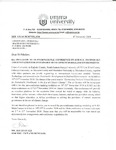| dc.description.abstract | This study aimed at molecular and biochemical characterization of Low Density Poly-ethene (LDPE) degrading fungi and bacteria from Dandora dumpsite-Nairobi. Twenty bacterial and 10 fungal isolates were identified using 16S rDNA and 18S rDNA sequences for bacteria and fungi respectively. The highest fungal degradation was attributed to Aspergillus oryzae strain A5, 1 while the highest bacterial degradation was attributed to Bacillus cereus strain A5,a and Brevibacillus borstelensis strain B2,2 respectively. Isolates were screened for their ability to produce extra cellular laccase and esterase; Aspergillus fumigatus strain B2,2 exhibited the highest presence laccase (15.67mm) while Aspergillus oryzae strain A5,1 exhibited the highest presence of esterase (14.33 mm). Alkane hydroxylase encoding genes were screened for using primer AlkB 1 which amplified the fragment of size 870 bp. Four bacterial samples were positive for the gene. Optimum growth temperature of the fungal isolates was 30˚C. The possession of laccase, esterase and alkane hydroxylase activities are suggested as key molecular basis for LDPE degrading capacity. Knowledge of optimum growth conditions will serve to better utilize microbes in the bioremediation of LDPE. The application of Aspergillus oryzae strain A5, 1 and Bacillus cereus strain A5,a in poly-ethene degradation is a promising option in this kind of bioremediation as they exhibited significantly high levels of biodegradation. Further investigation of more alkane degrading genes in biodegrading microbes will inform the choice of the right microbial consortia for bioaugmentation strategies. | en_US |

